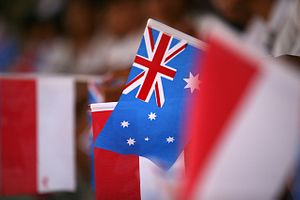Indonesia is one of Australia’s closest neighbors. But surprisingly the two G20 countries trade and invest very little between each other. In fact, it is difficult to find two G20 neighbors that trade and invest in each other as little as Australia and Indonesia do.
If you look at the numbers, Indonesia ranks as Australia’s 14th largest trade partner and Australia takes 10th place in Indonesia. The value of two-way trade stands at US$8.6 billion.
Compare these numbers to a couple other G20 neighbors in the table below.

Examples of bilateral trade among G20 economies. Source: World Bank World Integrated Trade Solution Analytical Data (2017), Author provided
The investment numbers are even more disappointing. The total Australian investment in Indonesia is less than 1 percent of Australia’s total outbound investment.
These numbers certainly do not reflect Indonesia’s rising economic importance and that it is predicted to become the fourth largest economy by 2050. Even if this prediction, based on a forward-looking report by PwC turns out to be too optimistic, Indonesia’s demographic dividend will still propel Indonesia’s economic growth over the next 25 years.
This narrative justifies a renewed effort on behalf of Australia to try and fix limping economic relations.
More than Indonessia’s Investment Risk
In July 2017 a group of Australian and Indonesian experts gathered in Perth, organized by the Perth USAsia Centre, to examine the causes behind weak economic relations and what can be done to improve them. In a report outlining their findings, the Perth USAsia Centre’s Working Group on Australia – Indonesia relations observed that both economies might not be complementary. Because of their reliance on natural resource exports Indonesia and Australia are actually competitors rather than collaborators.
In the report, the Working Group recognized Australian companies find it difficult to navigate Indonesia’s business climate. Foreign ownership rules and other regulations render attractive investments unappealing. Unable to withstand higher risk, Australian businesses move on to other opportunities.
But low risk tolerance cannot explain everything. Australian businesses have worked and thrived in complicated business environments elsewhere. Take China for example. With its lack of government transparency, shaky property rights, and bureaucratic corruption, it actually falls rather close to Indonesia on the World Bank’s ease of doing business index.
What Australia does have is a narrative China’s economic rise and how it has benefited directly from it. Driven by demand from China, Australia’s mining exports more than tripled within 10 years. This gave Australia’s per capita disposable income a prosperous boost.
Indo-Pacific Shares Narrative
Rather than perception of risk and uncertainty, the working group explained that Australia simply has yet to see Indonesia as an opportunity.
There is yet a narrative of Indonesia’s rise and what it could mean for Australian businesses. The working group recommended Australia and Indonesia to craft a shared “Indo-Pacific” narrative. Instead of perceiving each other as a threat, they should choose to see each other as an opportunity.
There are signs of change in the way Australia thinks about Indonesia. Australia opened a new consulate in Surabaya in September to focus on commercial engagement and expanding Australia’s diplomatic footprint in the country. Four Australian states have trade and investment representatives based in Jakarta.
The state of Western Australia this year appointed its first minister for Asian Engagement, Bill Johnston. With his portfolio comes a mandate to promote trade, investment, cultural links, and government-to-government ties. Minister Johnston is making his first visit to Indonesia in September.
On the business side, there are plenty of success stories. Interflour Group, an Australian joint venture with Indonesia’s Salim Group built flour mills in South Sulawesi and West Java and supplied them with Australian wheat.
To underscore the proximity advantage that Australia and Indonesia have, it takes a grain ship only nine days to travel from the grain terminal in Western Australia to sail to Makassar and back. A comparable trip to ports in southern China would take about 10 days one way.
IA-CEPA: Substantive Starting Point
Currently under negotiation, the Indonesia – Australia Comprehensive Partnership Agreement (IA-CEPA), might be a substantive starting point to revive Australia and Indonesia economic relations.
If finalised, the IA-CEPA would be Indonesia’s second substantive bilateral trade and investment deal, after its agreement with Japan went into force in 2008.
Now the IA-CEPA has completed its sixth round of negotiations. Both governments have committed to conclude the agreement before the end of 2017. The working group sees this goal critical to solving the tepid trade and investment climate.
![]() Indonesia and Australia find themselves locked together by geography in the midst of the most economically dynamic regions in the world. The choice is simple: work together and prosper or ignore one another and miss out on the benefits their proximity offers. With IA-CEPA and an earnest Australian strategy to engage with Indonesia, it looks like both countries are on the right track.
Indonesia and Australia find themselves locked together by geography in the midst of the most economically dynamic regions in the world. The choice is simple: work together and prosper or ignore one another and miss out on the benefits their proximity offers. With IA-CEPA and an earnest Australian strategy to engage with Indonesia, it looks like both countries are on the right track.
Kyle Springer is Program Manager at the Perth USAsia Centre, University of Western Australia
This article was originally published on The Conversation. Read the original article.
































